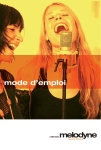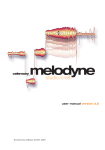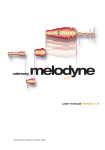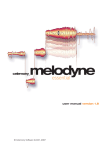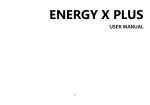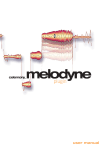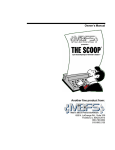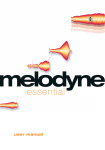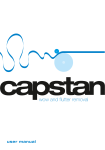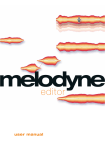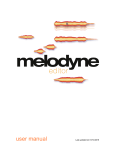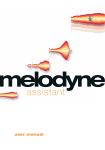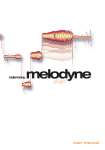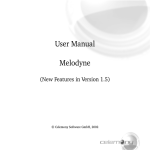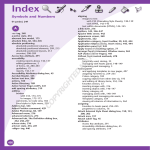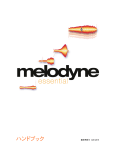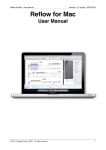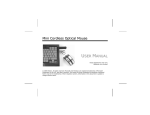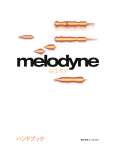Download manual - Celemony
Transcript
manual sound library Melodyne Sound Library Manual Author: Uwe G. Hoenig Translation: Ewan Whyte Celemony Software GmbH Valleystr. 25, 81371 München, Germany www.celemony.com [email protected] The manual and the software described therein are supplied under formal license. They may be used and copied only under the conditions of this licensing agreement. The data contained in the manual only serves for information purposes and may be changed without prior announcement. The information contained in the manual does not constitute a legal obligation of Celemony Software GmbH. Celemony is not responsible for any eventual faulty or inaccurate information contained in the manual. The manual and any parts thereof must not be reproduced or transmitted without the prior and explicit permission of Celemony Software GmbH. All product and company names are registered trademarks or brands of the respective companies. Apple, the Apple logo, Mac, Macintosh and Power Macintosh are registered trademarks of Apple Computer, Inc. Windows 98, Windows ME, Windows 2000, Windows XP and DirectX are either registered trademarks or trademarks of Microsoft Corporation. © Celemony Software GmbH, 2007 All rights reserved 2 Melodyne sound library The Melodyne Sound Library The Melodyne Sound Library Many thanks for purchasing the Melodyne Sound Library – and a warm welcome to one of the highest quality and most flexible sound collections for music production currently available! Each title in the Melodyne Sound Library is an archive containing many samples in a hierarchical and thematically arranged directory structure. Aside from the very high quality of the recordings, there is one thing that distinguishes the Melodyne Sound Library from other collections of samples on the market: all the recordings in the Melodyne Sound Library were conceived, produced and edited specially for use within Melodyne. This also applies to the 'detection' of the audio material; all the samples of the Melodyne Sound Library have already been subjected to this detection process and the results of the detection checked, corrected where necessary, and optimized. As a result, you have at your disposal very highquality samples that adapt fluidly to the requirements of the musical context and the tempo, pitch, scale and other characteristics of which can be modified at will. In this short introduction, we will explain how to install the Melodyne Sound Library, authorize it, and use the samples it contains. If you don't already know how to edit and vary the audio material, please consult the Melodyne User Manual, where you will find a multitude of suggestions and tips that will help you to get the most from your Melodyne Sound Library. We wish you every success making music with Melodyne and the Melodyne Sound Library! Best wishes, All at Celemony Melodyne sound library 3 Installation and activation Installation and activation of the Melodyne Sound Library This guide to activating your software only applies to Melodyne cre8 or Melodyne studio from Version 3.2 upwards. If you are using an older version of Melodyne, please follow the instructions in your User Manual. The Melodyne Sound Library is the product of long sessions in the studio and a great deal of editing and optimisation in postproduction. We hope you will understand therefore why it is copy-protected and has to be activated. To activate your library, please proceed as follows: • copy the library file from the CD/DVD to any location you like on your hard disk • launch Melodyne (using an administrator account if using Windows) • choose > Window > License to open the Activation Assistant You will see the status page confirming that Melodyne has been successfully activated. Click the "Activate Sound Bank" button. The sound bank activation page appears from which you can choose whether you wish to activate an MSL or a Liquid sound bank (see below). Select the option for MSL and click "Continue". The MSL activation page will appear. Here you must first enter the serial number of your MSL title. You will find this in the User Manual of your MSL. Now choose whether you wish to activate the MSL title online or offline. The symbol for a Melodyne Sound Library 4 Melodyne sound library Installation and activation Online Activation After selecting "Online Activation", click "Continue". On the Mac, you will then be asked to enter your Administrator Password. This is because Melodyne needs to store a license file derived from myCelemony in the root section of your computer. As soon as your computer has received the requisite activation data from the Celemony server, the Assistant will display the Status page again, where this time you will see your newly activated MLS title. You can then close the Assistant and start work with your MSL. Offline Activation Offline activation involves 3 steps: 1. exporting an activation request file from the activation assistant 2. transferring this file to a computer that is capable of connecting to the Internet and uploading the file to myCelemony 3. downloading the activation file and dragging it to the activation assistant and dropping it. If you have opted for offline activation, the "Export request file" page will appear: Melodyne sound library 5 Installation and activation Export the file by drag 'n' drop to your hard disk and transfer it (for example, using a USB flash drive) to a computer with Internet access. The request file is a small HTML file with a local web page that should open your browser when you double-click on it. If it fails to do so, open the file manually from your browser (the relevant command should be called "Open Page" or something similar). On the local web page displayed, you will see a button. Click on this to establish the connection with myCelemony and transfer the data required for the activation. As soon as the data has been transferred to the myCelemony server and processed, myCelemony will offer you the activation file to download. Clicking the link will commence the download. Where exactly the downloaded file is stored on your computer depends upon your browser settings. Please check these, if you cannot find the file after downloading it. Take this file to your music computer and launch Melodyne. When the activation assistant appears, simply drag 'n' drop the activation file into its window. You will be asked again for the administrator password of your computer, whereupon the assistant's status page will appear to confirm that the activation has been successful. An MSL activation applies to all the products registered on your myCelemony account that are capable of reading MSL sound banks. That is why it makes sense to use a single myCelemony account to register all your Celemony products. The same applies to offline registration. You cannot, and should not try to, open a new myCelemony account for an MSL title. The MSL 6 Melodyne sound library Installation and activation should be registered to the same account as your copy of Melodyne. Once the activation is successful, the activated MSL title will be displayed on the status page of the activation assistant Double-clicking the entry for an activated sound bank has two possible effects: - if Melodyne does not yet know where the sound bank is stored, a file select box opens, which you can use to localize the sound bank; - if Melodyne already knows where the sound bank is stored, double-clicking opens the Melody Manager window from which you can access the sound bank's samples. Melodyne sound library 7 Installation and activation No Internet? If you have no access to the Internet, you can request an activation by post from Celemony. Proceed as described above under "Offline Activation" and export the request file for the activation. Burn the file onto a CD and sent us the CD. You will then receive back from us an activation file on CD, which you will then be able to import exactly as though you had downloaded it from myCelemony. Please do not forget to send us your address! Our address is: Celemony Software GmbH Valleystrasse 25 81371 Munich Germany If you have been working with the demo version of a title from the Melodyne Sound Library and have used samples from it in your arrangement, you do not after purchasing the full version have to worry about reassigning samples. As soon as the full version is activated, Melodyne will automatically change all references to the demo version to references to the full version allowing you to continue working undisturbed. Please note that files from a Melodyne Sound Library cannot be moved or copied into the audio file folder of an arrangement. If you wish to transfer an arrangement that uses files from a Melodyne Sound Library to another computer, the relevant library must also be available and activated in the Sound Library window there as well (though it does not matter where on the second computer the requisite library file is stored). 8 Melodyne sound library Working with the Melody Manager Working with the Melody Manager The key component when working with samples from the Melodyne Sound Library is Melodyne's Melody Manager, which you can access via the File menu or with the shortcut [Shift]+[Command]+B. The Melody Manager is a file browser that displays only sample formats accepted by Melodyne, folders, and Melodyne arrangements, as well as offering a large number of very useful functions for working with samples. With the Melody Manager, you can navigate freely through the directory structures of your hard disk(s) as well as through the hierarchically arranged samples of the Melodyne Sound Library. At the same time, it is also a very powerful arranging tool: it displays the musical content of your samples and lets you hear them; you can also select parts of individual files as small as individual notes and drag them to the desired position in your arrangement. The Melody Manager window Melodyne sound library 9 Working with the Melody Manager Samples are represented by a Play button that you can click to hear the file. Clicking the button a second time stops the playback. As well as hearing the samples, you can see their content. You can make the window wider for this purpose and with longer files set the last column to display as much of the visual representation of the sound as possible. You can select the form of representation from the 'Show' list box at the top of the Melody Manager. You can display: only the name only the waveform only the notes the notes and the waveform or the typical 'blobs'. 10 Melodyne sound library Working with the Melody Manager You can also commence playback of an audio file by doubleclicking the waveform/note display (stopping it again with a single click) or start/stop playback of the selected file using the space bar. If you start playback with a double-click, playback begins from the position at which you clicked. If you select a passage within an audio file by dragging with the mouse and then doubleclick the selection, the passage selected will play back. Whichever representation mode you select, the pointer will indicate the playback position. You can select an entire file by clicking the title bar or select parts of it by dragging with the mouse; if notes are displayed, your selection is always placed at the borders between notes and you also hear precisely the notes selected. Selected notes in an audio file From the "Play" list box on the right, you can change the playback mode: "Normal" plays back the selected audio file once only; "Cycle" plays back the selected audio file in an endless loop, which is useful if you want to hear how it sounds cycled; whilst "Sequence" causes all the audio files in the current folder to play back one after another, which is obviously easier (when you want to hear the contents of an entire folder) than selecting and commencing playback of each file individually. The small rotary control to the right of the "Play" list box is the volume knob. The "Show" and "Play" list boxes in the Melody Manager with the volume knob on the right Melodyne sound library 11 Working with the Melody Manager For greater ease when arranging, you can either drag selected notes or an entire file (by dragging the title bar) into your Melodyne arrangement. The ability to drag extracts as short as individual notes allows you to create audio collages, where an entire melody, for example, is assembled from notes played on different instruments. You can also restructure a performance, or create a beat out of individual drum strokes and fragments of loops. With Melodyne, doing this type of thing is very easy. You can insert entire samples (by dragging the sample bar) or selected extracts into your arrangement or the Editor The Melodyne Sound Library can contain multi-voice ensembles composed of different voices. The samples for such ensembles are found in a sub-folder, which always contains a small arrangement as well, by means of which you can audition the complete ensemble. Please note that you cannot drag the arrangement symbol itself but only the individual voices one by 12 Melodyne sound library Adapting samples automatically one into your arrangement or the Editor. You can, of course, by double-clicking its entry, open an arrangement alongside the one you are working on and transfer samples from one arrangement to the other by copying and pasting. The symbolized Arrangement allows the auditioning of a multivoice ensemble in the Melody Manager Adapting samples automatically to the tempo and scale of your arrangement Naturally Melodyne offers you in connection with the Melodyne Sound Library all the advantages of almost infinitely elastic audio material: the tempo, pitch and scale of all the samples are variable and adapt automatically to your project as soon as you drag them (as described above) into it. For the adjustment to be performed automatically, you must observe the following points: Melodyne sound library 13 Adapting samples automatically • For the tempo of a sample to adjust automatically to the tempo of, and any tempo changes in, your project, you must check the Autostretch box in the Transport window or the Autostretch item in the Grid selection menu before dragging the file from the Melody Manager into the arrangement or Editor. The Autostretch option can be accessed from the Transport window or the Grid menu Note that the grid value selected affects the metric position at which you can insert the file. If need be, select a finer grid value. • For the pitch and scale of a sample to adjust automatically to the settings for those parameters in your project, you must activate the Scale Snap option in the bottom left-hand corner of the Editor before you drag the file into it. You can tell whether or not the tempo or scale of a sample is being adjusted to match those of the project into which you are about to insert it by reading the text that appears at the top of the rectangle enclosing the sample in the course of the drag 'n' drop operation; there you will see either 'Using Original Tempo' (in blue) or 'Adapting Tempo' (in red); and either 'Using Original Pitch' (in blue) or 'Adapting to Tone Scale xyz' (in red). The Scale Snap function ensures that an imported sample automatically adjusts to the scale you are using 14 Melodyne sound library Adapting samples automatically Note that the sample will only adjust to the scale if you drag it into the Editor; not if you drag it into the Arrangement window. Whether or not the tempo and/or scale of a sample are being adjusted to match those of the project is indicated by the text in the rectangle Naturally you can also modify the tempo, pitch and scale of a sample at any time subsequent to the drag 'n' drop operation using Melodyne's powerful editing functions. At the top left of the Melody Manager window, you will find two additional list boxes: one is labelled "Path" – this can be used to return to a particular folder in the hierarchy – and the other "Actions". The latter allows you to perform various operations on the audio file currently selected such as: – Open in new Arrangement (like Open in Melodyne's File menu) results in the creation of a new arrangement into which the selected audio file is inserted. Double-clicking on the name of an audio file has the same effect (unless you have selected the option Double-clicking on a file opens the MDD Editor in the Preferences dialog) – Add to current arrangement (like Import Audio File in Melodyne's File menu) causes the selected audio file to be Melodyne sound library 15 Checking the rhythm and adapting to the groove inserted into the current arrangement on a new track at time position zero without tempo adjustment The other items in this menu are irrelevant to the Melodyne Sound Library. N.B. Remember that the MDD files belonging to samples from the Melodyne Sound Library have already been optimized; they require no further editing, which is why it is impossible to edit them. Checking the rhythm and adapting to the groove Since you have the right to expect more from a high-quality library than robotic material that has been quantized to death, the samples in the Melodyne Sound Library retain not only the pitch but also the groove of the original musical performance. This special rhythmic feel can give your arrangement the extra touch of authenticity and vibrancy that makes the difference between an outstanding production and one that is merely good. Naturally, however, a certain degree of sensitivity and care is called for here. When combining different samples, you should always pay attention to the way they interact rhythmically and the groove of the sample combinations. Where samples clash or are out of step, Melodyne offers a wide variety of powerful functions to overcome the problem and ensure that the various tracks gel. First select the track or a passage thereof that you wish to correct and open the Quantize Time window from the Edit menu; 16 Melodyne sound library Checking the rhythm and adapting to the groove you should do this while the tracks to be edited are playing back (you can always stop and restart the playback while the window is open). While the macro window is open, you can 'straighten out' the The macro window for time correction problematic samples with a variable degree of intensity and on the basis of different note grids. Melodyne's audio quantizing is very sensitive and intelligent in its operation – try out various note grids and intensities to get a sense of their effect and to get closer to the desired timing ideal. You can hear all the changes you make in real time. In addition to a basic note grid, you can select from the list box at the top right a reference track for the quantization; both options will then work together to adjust the material to the reference track with the degree of intensity desired. You could, for example, adjust the groove of a rhythm guitar part to that of a percussion track or vice versa. When you are satisfied with the results, quit the window with OK. You can always reverse the effects of the quantization later with the Undo function. Finally we would like to emphasize once more that this short guide was only intended to introduce you to the most elementary and essential editing options! Consult the Melodyne User Manual to learn more about the unique possibilities Melodyne offers for the handling of audio material. Melodyne sound library 17

















